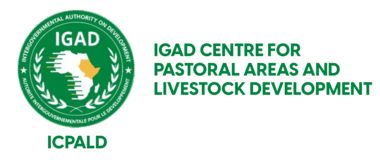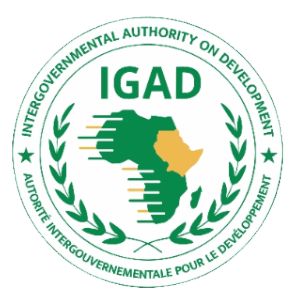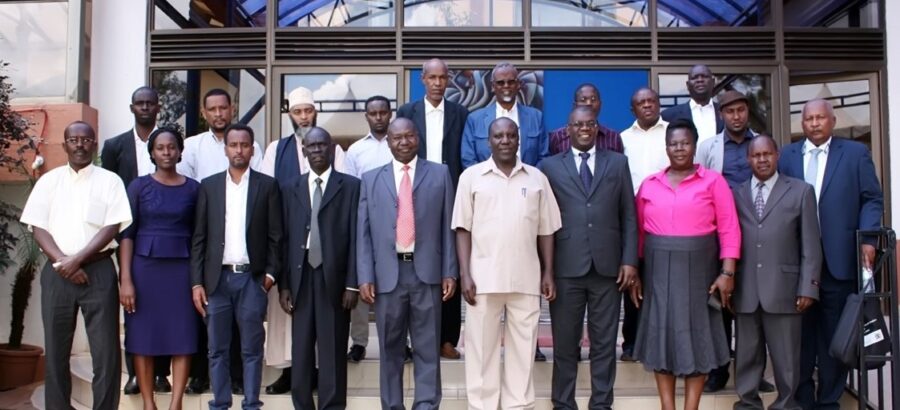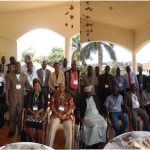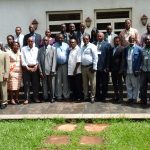Introduction
A follow-up meeting of the Regional Network for Quarantines was organized in Kampala from 9th to 11th November 2016 with the main aim of operationalizing the network to foster harmonization of standard and activities, including sharing of information among experts driving the quarantine system. A total of 21 participants drawn from Djibouti, Ethiopia, Kenya, Somalia (Somaliland, Puntland) South Sudan, Sudan and Uganda, AU-IBAR and ICPALD attended the meeting.
In his remarks, Dr Joseph Magona, on behalf of Dr Solomon Munyua, the Director of the IGAD Centre for Pastoral Areas and Livestock Development (ICPALD), stated that quarantines had been spearheaded in the IGAD region as a feasible model for promoting livestock trade, given that several transboundary animal diseases being endemic in the region. Such facilities gave an opportunity for animals to be screened for diseases and for negative and health animals to be shipped to export markets, especially in the Middle East and North Africa. Given the fragmented manner in which quarantine stations operate, there was need to regulate Sanitary and Phyto-Sanitary Standards in quarantine stations across the region, taking in account consumer and end market interests in importing countries. Therefore IGAD/ICPALD decided to bring together quarantine stakeholders to establish the Regional Network for Quarantines.
In his remarks, Dr George Matete, on behalf of Prof. Ahmed Elsawalhy, Director of African Union Interafrican Bureau for Animal Resources (AU-IBAR), stated that AU-IBAR had established strategic partnerships to bring together stakeholders to open up the market opportunities. He further said that networks of stakeholders through Public Private Partnerships (P-P-P) were a good vehicle to improve trade and livelihoods. He pointed out that the horn of Africa and the IGAD region at large is known for pastoralism especially along the South Sudan, Ethiopia, Uganda and Kenya borders that have a lot of cross border movements. He further stressed that trade bans affect everyone in the region hence it was important to build increased capacity for quarantines especially in laboratory testing for trade sensitive diseases such as brucellosis. He further stressed that P-P-P were necessary for sustainability of quarantine operations and the private sector was essential sustaining business. Governments had a essential regulatory role. Finally, he stated that in support of quarantines in the Somali Region, AU-IBAR through the SMP-AH, ESOLT and RAHS project recently trained 38 Somali nationals in Egypt on laboratory techniques vital for quarantine laboratory operations.
In his remarks, Dr. Dawud Ahmed Issa, the Coordinator for the Regional Network for Quarantines stated that the network was formed in Khartoum, Sudan in 2015 to enforce SPS standards in order to secure end markets. He stated the network was now a member of the Regional Network for Animal Health (RAHN) as per the recommendations of the recent RAHN meeting held in Dar-Es-Salaam in October 2016. Finally, he thanked AU-IBAR and ICPALD for supporting the network, USAID for financial support and Uganda for hosting the meeting.
In his official opening, Dr Nicholas Kauta, Director Animal Resources, Uganda welcomed everybody to Uganda. He pointed that stakeholders were building a network for quarantine facilities in order to initiate the process of advancement. He encouraged all quarantine stakeholders to be solution-oriented and dismantle tradition barriers. It was his hope that technical and political leaders would support the Regional Network for Quarantines to allow for progress.
- Meeting objectives
The meeting had the following objectives:
- To develop further network documents such as the Strategic plan
- To share information among experts driving quarantine systems in the Region
- To discuss challenges and means of re-inforcing compliance to SPS standards within quarantine systems in the region
- To disseminate the SMP on Export Quarantine
- To identify areas in the quarantine systems that require development of Standard Operating Procedures for Livestock Quarantine System
- To visit the new quarantine and feedlot system for Uganda Meat Producers Cooperative Union in Luwero, Uganda
- Proceedings
The following topics were discussed:
- SMP-AH Overview and status of quarantine activities
- Country presentations on status of quarantines facilities, status of trade
- Challenges and means of re-inforcing compliance to SPS Standards within quarantine systems in the region
- Identification of areas for quarantine systems that require develop of Standard Operating Procedures for Livestock Quarantine Systems
- Development of the Strategic plan for the Regional Network for Quarantine
- Tour to Uganda Meat Producers Cooperative Union, quarantine and feedlot facility and livestock farmers in Luwero, Uganda
- A field visit to Uganda Meat Producers Cooperative Union, Luwero, Uganda
UMPCU has 2700 livestock farmers with 2450 of them having about 200 to 300 cattle and about 250 of them having about 400 to 600 on fenced farms with a few having up to 4,000 cattle. The elite farmers have contracts with the Union to supply 140 cattle per year for slaughter. These farmers can also buy from the small farmers. Small farmers are allowed to buy animals from primary markets. A virtual account system is employed by the Union to provide support and sustained market for animals throughout the year. The quarantine facility holds animals supplied by farmers before being delivered to the export abattoir.
3.2 Country presentations
3.2.1 Djibouti
Prima International Regional Quarantine, a key facility in Djibouti, presented its update status. The facility undertakes pre-quarantine activities, including, preliminary physical examination of livestock as first screening to detect disease problems and sick animals for treatment. The facility has 12 pens for sheep and 10 pens for cattle and camel located 3Km from station A-B.
Quarantine Procedures include, Animal Inspection at border posts and Djibouti port; Inspection at pre-quarantine for animals brought by on hoof by traders; Inspection at quarantine gate; Individual examination after 1-2 days and ear tagging, blood testing and vaccination; Daily observation, treatments, prophylaxis, isolation, culling throughout the period; and Observation during loading and shipment. In addition, quarantine measures for pest control are carried out. The facility also regularly undertakes training of personnel on strategies and policies.
In 2016, testing livestock at the quarantine facilities for brucellosis detected 1.52% of the sheep, 6.85% of the cattle and 13.64% of the camels seropositive for brucellosis. Overall, 100,514 shoats, 59,260 cattle and 11,361 camels were exported through the quarantine facilities. Currently the Government of Djibouti is developing a private port for the quarantine to facilitate the movement and transport of livestock. The major challenges faced by Prima International quarantine included the following: (1) Less demand from importing countries, (2) Low price at end market, (3) Devaluation of local currency in some of importing countries such as Egypt, (4) Absence of price adjustment according to demand of market in exporting countries such as Ethiopia, and (5) Dominance of illegal cross border trade to neighboring countries.
3.2.2 Ethiopia
In 2014/2015, Ethiopia exported 535,620 live animals amounting to 148.5 million USD in value. Major quarantine stations are being developed in Mille and Jigjiga. Mille quarantine has a capacity of 600 hectares. Only 48 hectares have been utilized, holding 87 pens with 11 being for small ruminants and 76 for larger stock, including 44 for cattle and 30 for camels. Major challenges experienced include, (1) less trust on exporting countries capacity, (2) limited market, (3) limited exchange of market information among value-chain actors, and (4) unavailability of modern livestock market centers.
3.2.3 Kenya
In Kenya, the Livestock Export Zone has been established at Bachuma in Taita Taveta County. The major objectives for the establishment is (1) Facilitate livestock and livestock products to local, regional and international markets, (2) Improve sustainable rural livelihoods and food security and (3) Strengthen institutions in the livestock sub-sector. The Bachuma Livestock Export Zone (LEZ) has an Area of 15,000 acres and only 200 acres have been developed. Phase I Started in March 2015 covering (1) Bio-security fence- Trench, outer chain linked, inner barbed wire, (2) Pens- 9 for large stock and 6 for small stock, (3) Sheds, (4) Borehole, (5) Gate house, (6) Staff houses and (7) Laboratory. Currently it is 95% complete
Phase II started in March 2016 involving establishing (1) Internal roads, (3) Administration block (4) Workshop, (5) Watch towers, (6) Laboratory, (7) Emergency slaughter house, (8) Feed store, (9) Mechanical and electrical works. Currently at 30% complete. Due to financial constraints, the Government has initiated a discussion with a private developer to complete and run the facility on a lease agreement.
- South Sudan
In South Sudan, quarantine points and checkpoints have been established at Nimule along the South-Uganda border, Nadapal along the South Sudan-Kenya border, Juda, Kaya along the South Sudan-Uganda border and at Juba International Airport. From January to May 2016 upto 300,400 cattle, 490,505 goats and 350,600 sheep passed through the Nimule quarantine and check point from Uganda to South Sudan. While 304,000 cattle, 450,000 goats and 500,000 passed through Torit check point to South Sudan from Uganda. The major challenge is lack of political stability.
3.2.5 Sudan
Sudan has an annual target capacity for quarantines of 15,811,000 sheep and 12,485,000 cattle. Its major challenges include, (1) deterioration of pasture quality due to extension of mechanized farming, mining and oil exploration, (2) prevalence of TADs in the country inflicting heavy losses and affect livestock exports, (3) lack of responsible and competent body to manage the livestock markets in proper way, (4) traditional production system for livestock, (5) Livestock producers lack new information and technologies about animal health issues, (6) limited number of vets at field level and evenly distributed throughout the country, (7) Limitation of operational funds, (8) Inadequacy of cold storages for meat export and unreliable transport facilities for both live animals and meat is one of main constraints in the sector.
3.2.6 Uganda
Uganda has a livestock population of 14,452,253 cattle, 15,770,856 goats, 4,320,156 sheep, 4,033,772 pigs, 47,432,788 chicken, 1,847,271 ducks and 441,234 turkeys estimated at 3% growth from the 2008 census. A private quarantine facility has been set-up in Nakaseke. It has no government quarantine facilities. Recently Government has established a Meat Export Support Project (MESSP). Its main purpose is to establish a meat value chain in Uganda which achieves increase in livestock production considering both quality and quantity through to processing
Puntland State of Somalia
Bossaso is a major export quarantine facility in Puntland with an average annual export of 85255 cattle, 18446 camel and 1333424 shoats. Export destination include, Oman, Dubai, Saudi Arabia, Kuwait, Bahrain, Egypt, Qatar and Libya. Origin of export animals include, all region in Puntland contributing 52%, Southern Somalia contributing 30% and Ethiopia 18%.
Somaliland
Berbera is the main port of Somaliland and it locates northern coastal areas of Somaliland. Each year 3-4 million of live animals are exported through Berbera port by three functional quarantines below;
1) Berbera Saudi Emirates Quarantine (opened on September of 2009): holds up to 500,000 animals each time.
2) Berbera National Animal health Quarantine (opened on 31th October 2010): holds up to 250,000 animals each time.
3) Veterinary Berbera united Quarantine (opened on 2015): holds up to 400,000 animals each time. Major challenges include, (1) Unskilled labor in quarantines unaware of animal welfare, (2) provision of feeding for livestock intend for export, (3) unavailability of enough water and fodder to animals during severe droughts, (4) poor infrastructure for the livestock market, and (5) shipment expenses for quarantines that have to hire ships.
Recommendations
To the Regional network for quarantine
- To official call the regional network for quarantines as the Eastern Africa Network for Export Quarantines (EARNEQ) as per the recommendation of the Regional Animal Health Networks (RAHN)
- To include other non IGAD countries but within Eastern Africa in the EARNEQ
- For the EARNEQ to have countries, namely, Burundi, Djibouti, DRC, Eritrea, Ethiopia, Kenya, Somalia (Somaliland, Puntland and Federal Rep of Somalia), South Sudan, Tanzania and Uganda as its member countries
- To have all member countries identify two focal persons representing Government and the private sector as further as quarantines as concerned.
- To ensure that all EARNEQ focal persons attended Regional Animal health Network meetings
- To have Dr Khidir Elfaki from Sudan replace Dr Ahmed Shouldrein as a Deputy Coordinator for the EARNEQ.
To AU-IBAR, MS and IGAD/ICPALD
- To help establish a legal framework on how the network members would work as a unit
- Way forward
Have the first draft of the strategic plan for the network circulated by ICPALD to members within two weeks (by 25th November 2016. The next network meeting will be in Tanzania by February 2017
